![]()
![]()
![]()
Use LEFT and RIGHT arrow keys to navigate between flashcards;
Use UP and DOWN arrow keys to flip the card;
H to show hint;
A reads text to speech;
50 Cards in this Set
- Front
- Back

|
Jacques-Louise David
Coronation of Napoleon 1805-1808 Neoclassical (structured composition) Napoleon crowning his wife while Pope watches (underscoring authority of state over church) Adhered to historicity until Napoleon asked for some changes (like his mom showing up) Conceptually divided the painting to highlight polarities (religious on right, court on left) |
|
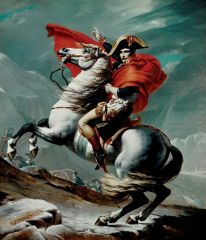
|
Jacques-Louise David
Napoleon Crossing the Saint-Bernard Pass 1800-1801 Neoclassical Propagandist: Dramatic lighting, tiny other ppl, proportion to the horse |
|
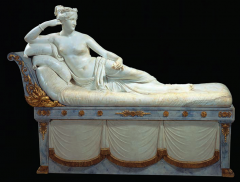
|
Antonio Canova
Pauline Borghese as Venus 1808 Neoclassical sculpture Napoleon's sister as Venus (hence reclining) Based on Greek statuary: sensuous pose, seminude body Mixed media and detail in chair suggest Baroque Small hands, feet, elongated neck suggest Mannerist |
|
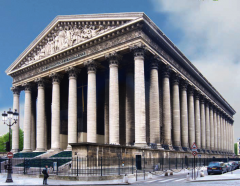
|
Pierre Vignon
La Madeleine 1807-1842 Neoclassical architecture "temple of glory" for armies, to link Napoleon to Roman empire |
|
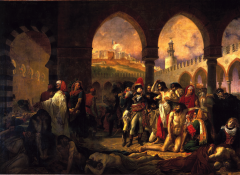
|
Antoine-Jean Gros
Napoleon at the Pesthouse at Jaffa 1804 Neoclassical: Muscular figures in robes, stagelike, dramatic lighting, series of arches Non: Pointed arches, emphasis on (exotic) local culture, lighting is dusky and atmospheric |
|
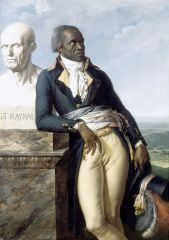
|
Anne-Louise Girodet-Trioson
Jean-Baptiste Belley 1797 Neoclassical Senegalese-Haitian ex-slave and French legislator Idealized, exotic (ear ring) and unconventional subject |
|
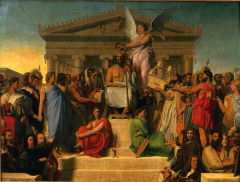
|
Ingres
Apotheosis of Homer 1827 Neoclassical Winged Fame crowns Homer before Ionic temple Symmetrical, organized composition Inspired by School of Athens |
|
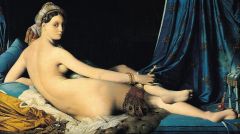
|
Jean-Auguste-Dominique Ingres
Grande Odalisque 1814 Neoclassical: reclining female nude Mannerist: languid pose, small head, elongated limbs, cool color scheme Romantic: exotic (Turkish woman in harem) |
|
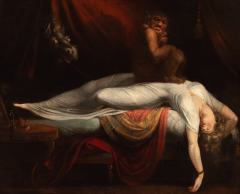
|
Henry Fuseli
The Nightmare 1781 Romantic: emphasis on feeling over reason Incubus sits on torso, eye-less horse peaks in Dark terrain of human subconscious |
|
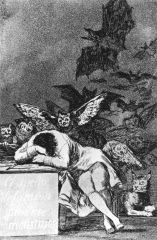
|
Francisco Goya
The Sleep of Reason Produces Monsters ca. 1798 Goya depicted as asleep while creatures converge Enlightenment: owls = folly, bats = ignorance, show value of reason and rational Romantic: Unleashing of imagination, emotions, nightmares for creativity |
|

|
Francisco Goya
Third of May, 1808 1814-1815 Historical, Romantic Goya encouraged empathy for massacred peasants Horrified expressions, endowing humanity vs. anonymous French soldiers Cruciform gesture of main figure |
|
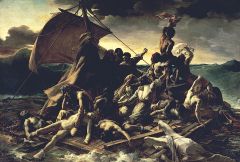
|
Theodore Gericault
Raft of the Medusa 1818-1819 Historical, Romantic Jumble of writhing bodies in every attitude of suffering Grandeur of Neoclassical history painting Artist's commentary on practice of slavery, criticism of French gov't |
|
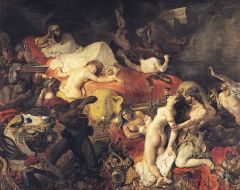
|
Eugene Delacroix
Death of Sardanapalus 1827 Romantic Inspired by poem Richly colored and emotionally charged canvas Filled with exotic, erotic figures |
|
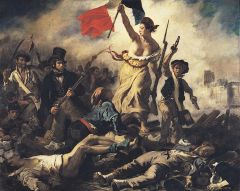
|
Eugene Delacroix
Liberty Leading the People 1830 Romantic Balanced mix of history (actual landmark) and poetic allegory Allegorical personification of Liberty Ex-slave on left |
|

|
John Constable
The Haywain 1821 Romantic Nostalgic view of disappearing English countryside Muted greens, delicacy of brushstrokes complement tranquil scene Figures blend in, representing oneness w/ nature |
|
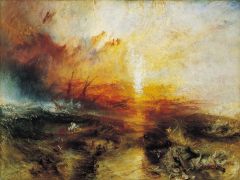
|
J.M.W. Turner
The Slav Ship 1840 Innovative style: use of emotive power of color Released it from defining outlines to express forces of nature and painter's emotional response to them Reinforces feeling of sublime w/ immense power of nature over humans |
|
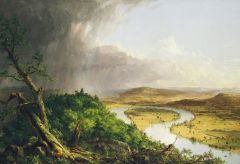
|
Thomas Cole
The Oxbow 1836 Romantic landscape Expansive wilderness incorp. romantically appealing moods and reflections Cole divided his canvas into dark wilderness on left and sunlit civilization on right |
|
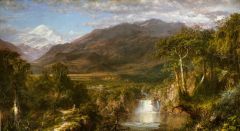
|
Frederic Edwin Church
The Heart of the Andes 1859 Romantic landscape Very realistic, no moralizing narrative Depicts idealized landscape Painstakingly detailed, accurate specifics (but not setting) |
|
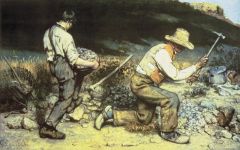
|
Gustave Courbet
The Stone Breakers, 1849 Realistic: championing everyday life Palette of dirty browns and grays Conveyed dreary and dismal nature of menial labor in mid-century France |
|
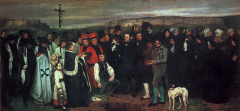
|
Gustave Courbet
Burial at Ornans 1849 Realistic Ordinary nature of the subject and Courbet's starkly antiheroic composition Faces are portraits Presented viewer w/ mundane realities of life and death Not theatrical like Romanticism |
|
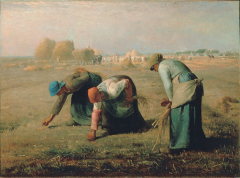
|
Jean-Francois Millet
The Gleaners 1857 Realistic French country life 3 Impoverished women gathering the scraps left in the field after harvest Backbreaking task of gleaning |
|
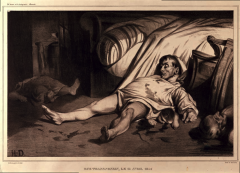
|
Honore Daumier
Rue Transnonain 1834 Realistic lithograph Social criticism and political protest of massacre View of slaughter from a sharp angle, terrible quiet aftermath Power of print lies in factualness |
|
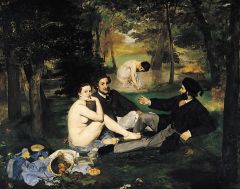
|
Edouard Manet
Le Dejeuner sur L'Herb (Luncheon on the Grass) 1863 Realistic? Moves away from illusionism Used colors to flatten form and draw attention to painting surface Abrupt changes in tonality |
|
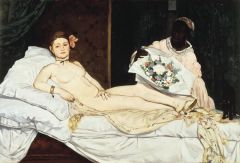
|
Edouard Manet
Olympia 1863 Realistic? Looks at viewer with cool indifference; shamelessness Black maid evokes inferiority and animalism(???) Rough brushstrokes, abrupt shifts in tonality |
|

|
Henry Ossawa Tanner
The Thankful Poor 1894 Realist Careful study of nature w/ dignity of black American families Expressive lighting reinforces reverent spirit Sense of sanctity expressed in everyday experience |
|

|
Edmonia Lewis
Forever Free 1867 Realistic (themes) Stylistic debt to Neoclassicism Man stands in heroic contrapposto Possible reference to female subordination in black community? |
|

|
Hawes & Southworth
Early Operation under Ether, Massachusetts General Hospital ca. 1847 Early daguerreotype Demonstrates power of new medium of photography Puts viewer in position of med student Focus is white-draped pt. Slight blurring betrays motion during the exposure Elevated viewpoint flattens perspective, emphasizes relationships of figures; like Degas (Impressionism) |
|

|
Nadar
Eugene Delacroix ca. 1855 Realistic(?) photograph Earliest portrait photographers Reveals personalities of sitters and records features |
|
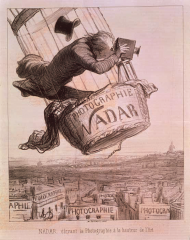
|
Daumier
Nadar Raising Photography to the Height of Art 1862 Realistic(?) lithograph "Elevating the art of photography" |
|
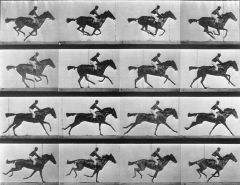
|
Eadweard Muybridge
Horse Galloping 1878 Realistic(?) photography Successive stages of motion, details too quick for human eye to capture Modern cinema owes him big time |
|
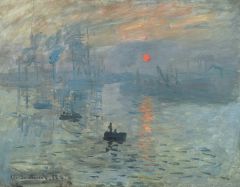
|
Claude Monet
Impression: Sunrise 1872 Impressionist: incorporates qualities of sketches Abbreviation, speed, and spontaneity No attempt to disguise brushstrokes or blend pigment Acknowledging the paint and canvas surface Attempted to catch the quality of light and the colors it produced |
|
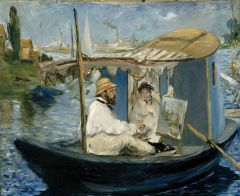
|
Edouard Manet
Claude Monet in His Studio Boat 1874 Impressionist Documents first time someone paints outside Monet on his boat studio, doing it plein air Important b/c mid-century Realist admiring young Impressionist painter (Manet-->Monet) |
|
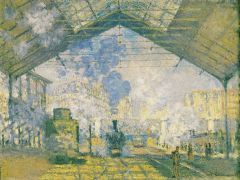
|
Claude Monet
Saint-Lazare Train Station 1877 Impressionist Unintelligible at close range, eye fuses brushstrokes at distance Agitated application of paint contributes to sense of energy in urban scene No feeling of social fabric, a hallmark of Impressionism |
|
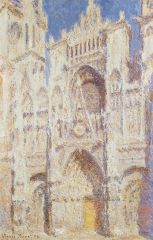
|
Claude Monet
Rouen Cathedral: The Portal (in Sun) 1894 Impressionist Series of views of Cathedral @ different times of day/in diff climates The real subject is the sunlight shining Zenith of Monets experiments w/ light |
|
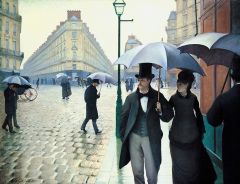
|
Gustave Caillebotte
Paris: A Rainy Day 1877 Impressionist Didn't use Impressionistic brushstrokes Seemingly random placed figures, arbitrary cropping Transitory nature of modern life |
|

|
Berthe Marisot
Villa at the Seaside 1874 Impressionist Swift, sketchy strokes of light colors to convey feeling of airiness Did not linger on contours or enclosed details Mood of relaxed leisure, woman not paying attention to child |
|
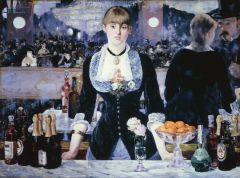
|
Edouard Manet
A Bar at the Folies-Bergere 1882 Impressionist Calls attention to canvas by creating spatial inconsistencies Barmaid and her apparent reflection in mirror? Waitress seems lost in thought, disinterested in patron |
|
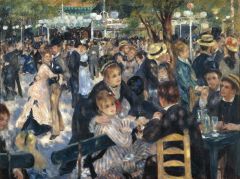
|
Pierre-Auguste Renoir
Le Moulin de la Galette 1876 Impressionist Parisian dance hall dappled w/ sunlight and shade Blurred into figures, produce effect of floating and fleeting light |
|
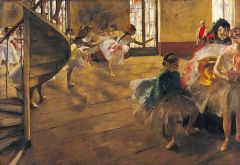
|
Edgar Degas
The Rehearsal 1874 Impressionist Arbitrarily cut-off figures Patterns of light splotches Blurry images Prominent diagonals of wall bases and floorboards |
|

|
Mary Cassatt
The Bath ca. 1892 Impressionist Owes to Degas and Japanese prints Tender relationship between mother and child |
|

|
James Abbott McNeil Whistler
Nocturne in Black and Gold (The Falling Rocket) ca. 1875 Impressionist Interest in conveying atmospheric effects of fireworks at night Emphasizes abstract arrangement of shapes and colors |
|
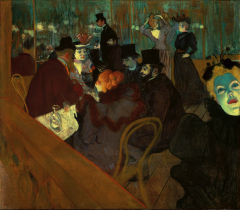
|
Henri De Toulouse-Lautrec
At the Moulin rouge 1892-1895 Post-Impressionist Degas, Japanese prints, photography influenced oblique composition Glaring lighting, mask-like faces Dissonant colors distinctly T-L Sloping, flattened space; brushstrokes; abrupt shift in tonality |
|

|
Georges Seurat
A Sunday on La Grande Jatte 1884-1886 Post-Impressionist Pointilism: dividing colors into components, applying colors to canvas in tiny dots Forms comprehensible only from a distance |
|
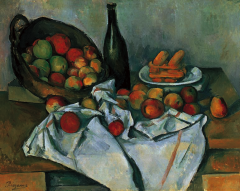
|
Paul Cezanne
Basket of Apples ca. 1895 Post-Impressionist still life Solidity of bottles and fruit by juxtaposing color patches Resulting abstract shapes not optically realistic |
|
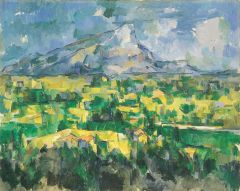
|
Paul Cezanne
Mont Sainte-Victoire 1902-1904 Post-Impressionist Transitory visual effects of changing atmospheric conditions Careful analysis of lines, planes, colors of nature |
|
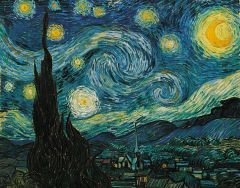
|
Vincent van Gogh
Starry Night 1889 Post-Impressionist Abstract pattern of expressive line, shape, and color Painted the vast night sky filled w/ whirling and exploding stars Feelings about electrifying vastness o/t universe Earth and humanity huddling beneath it |
|

|
Paul Gauguin
Where Do We Come From? What Are We? Where are We Going? 1897 Post-Impressionist Native women of Tahiti and tropical colors Pessimistic view of inevitability of life cycle |
|
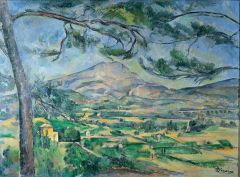
|
Cezanne
Mont Sainte-Victoire ca. 1887 Post-Impressionist Idea of 'passage' or blending of back- w/ foreground (Foliage of trees smeared w/ colors of mountain) Line of tree is parallel w/ mountain Interest in capturing effects of what we see |
|
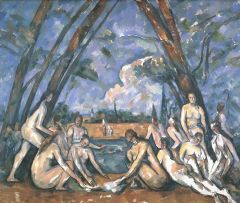
|
Cezanne
The Bathers 1906 Post-Impressionist 'passage' all over the place! (women's hair, women in line with trees) Supposed to be a Gotchic cathedral? (Arch of trees, lightness in center) |
|
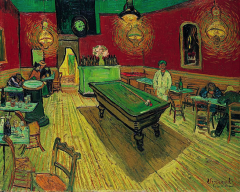
|
Vincent van Gogh
Night Cafe 1888 Post-Impressionist Exploration of ways color and distorted forms can express emotions Thickness, shape, direction of brushstrokes create tactile counterpart to intense colors Concerned w/ creating a mood (Expressionist) Calmness/quietness/despair vs. anxiety, over-stimulation |

